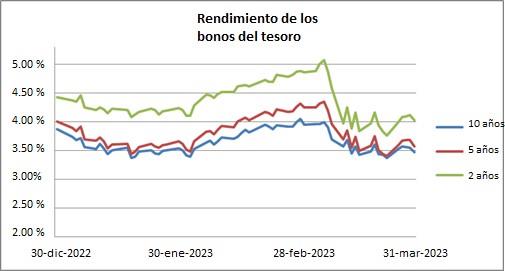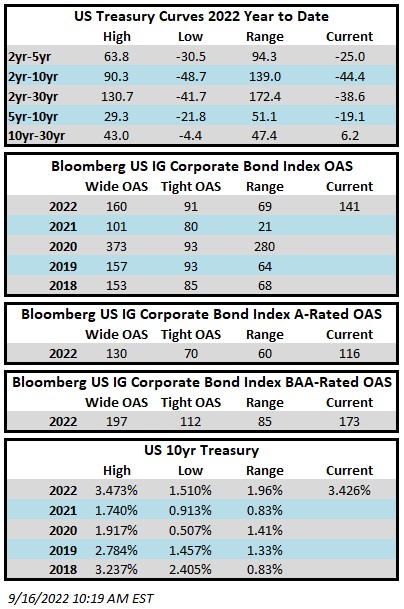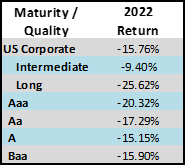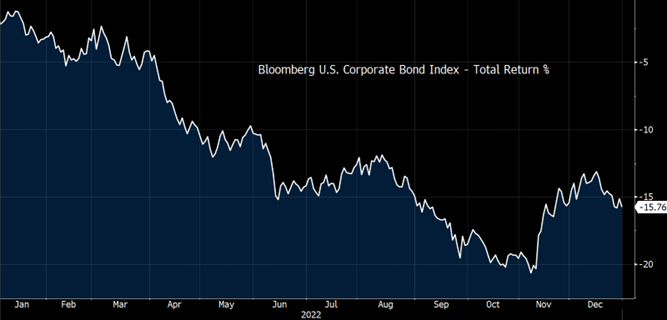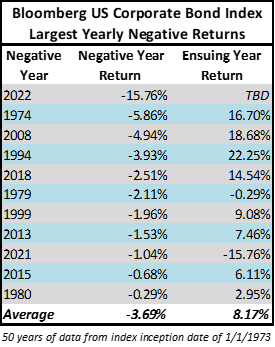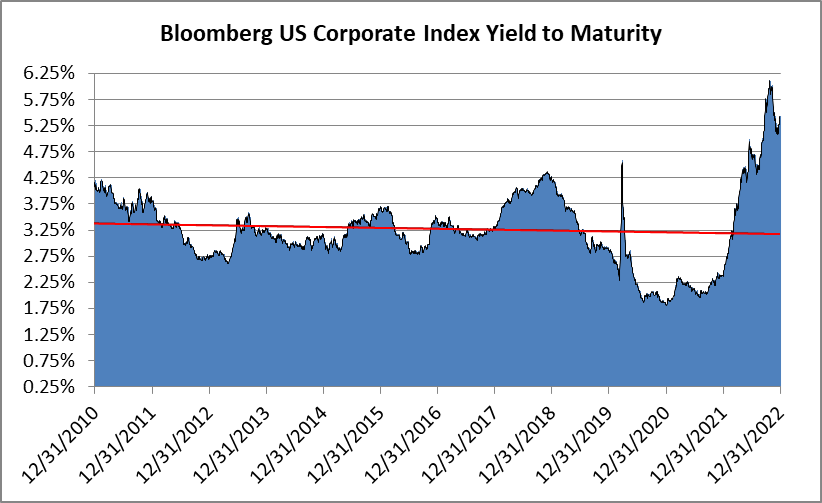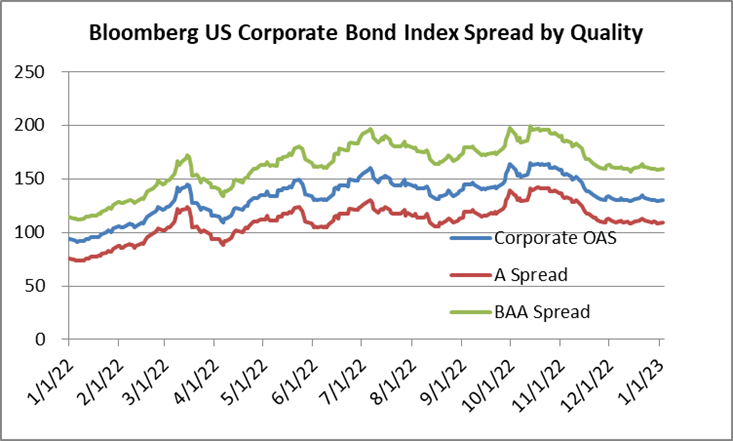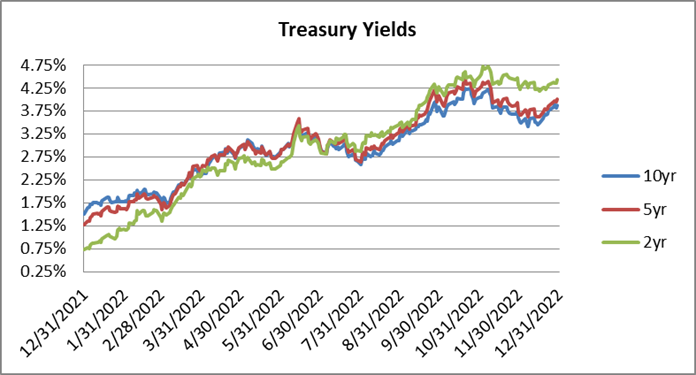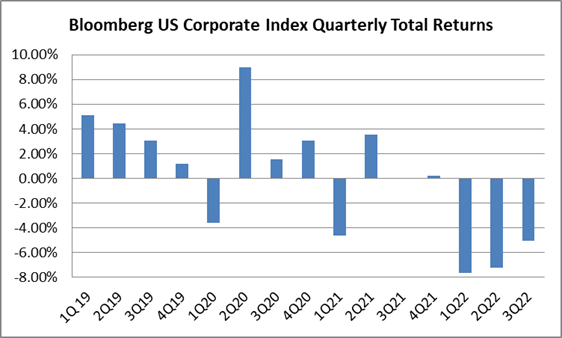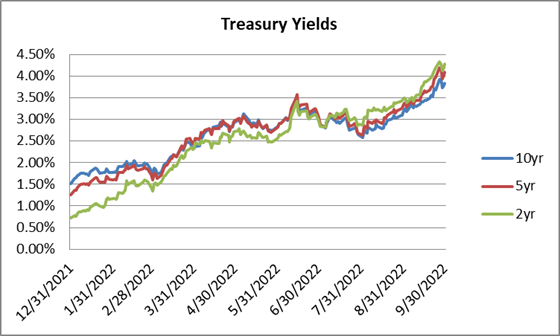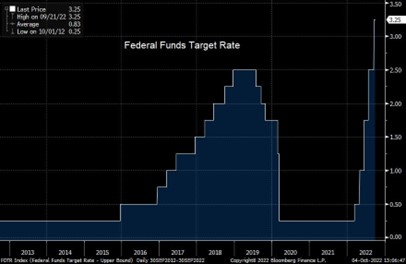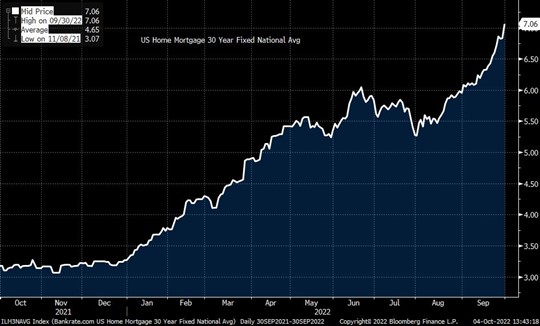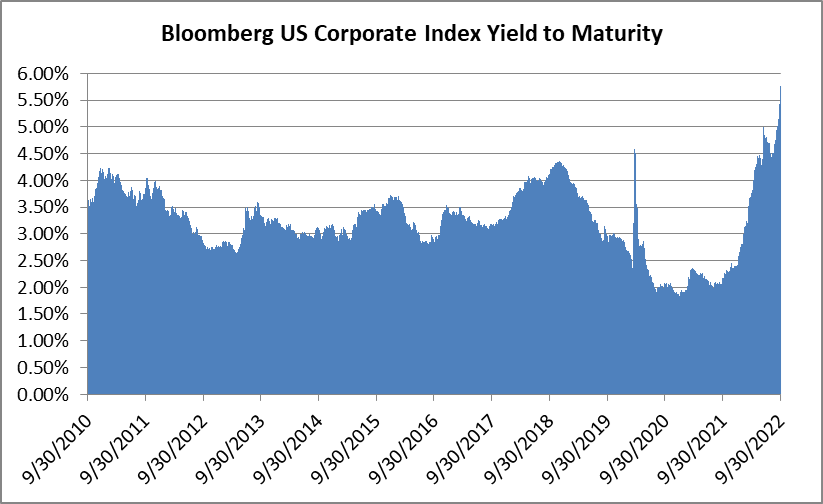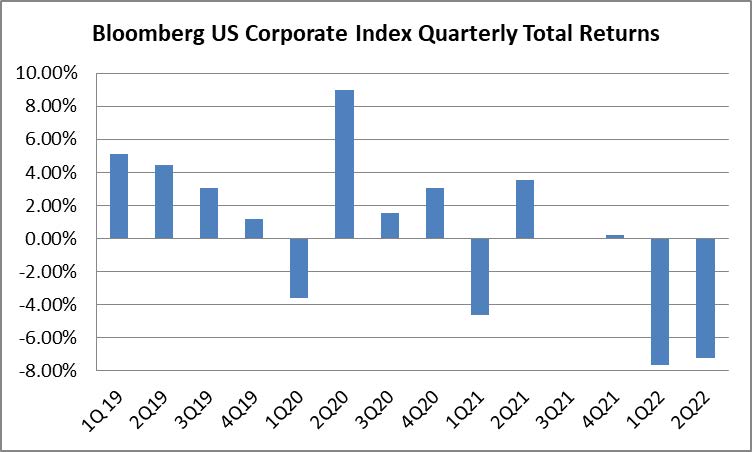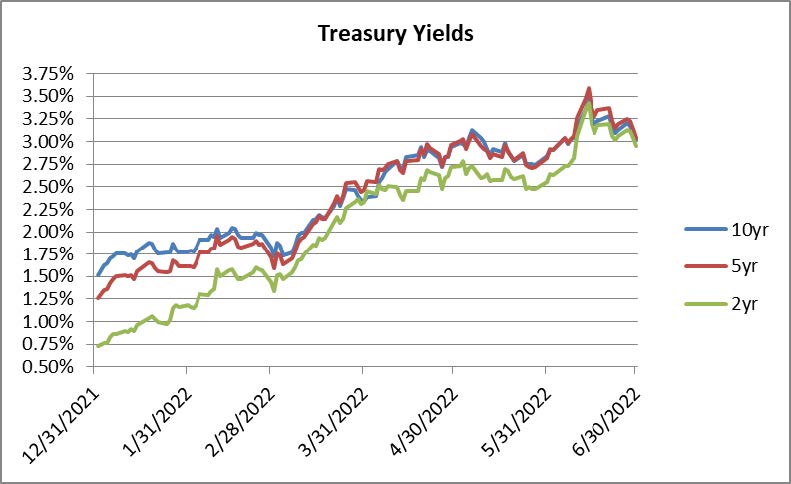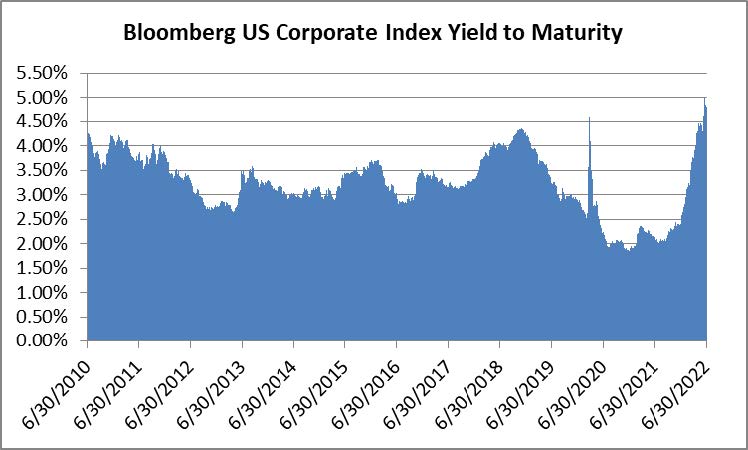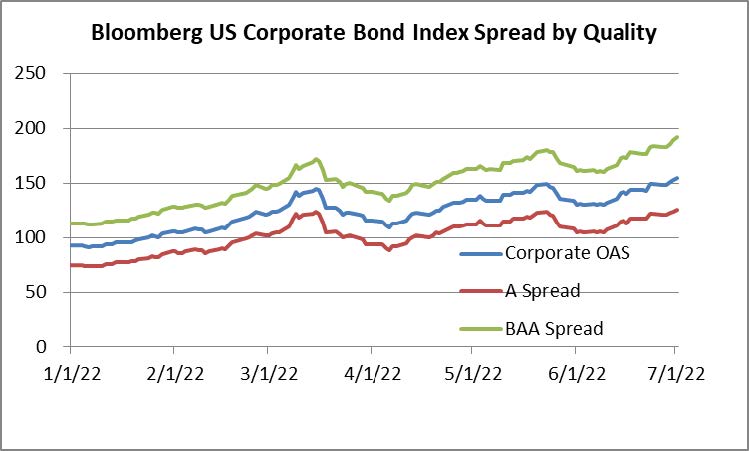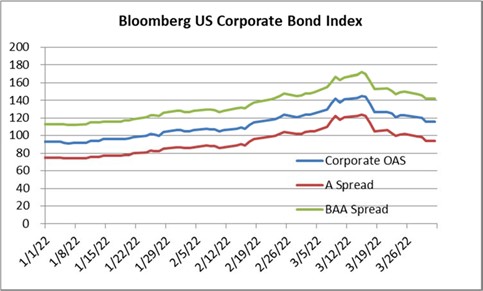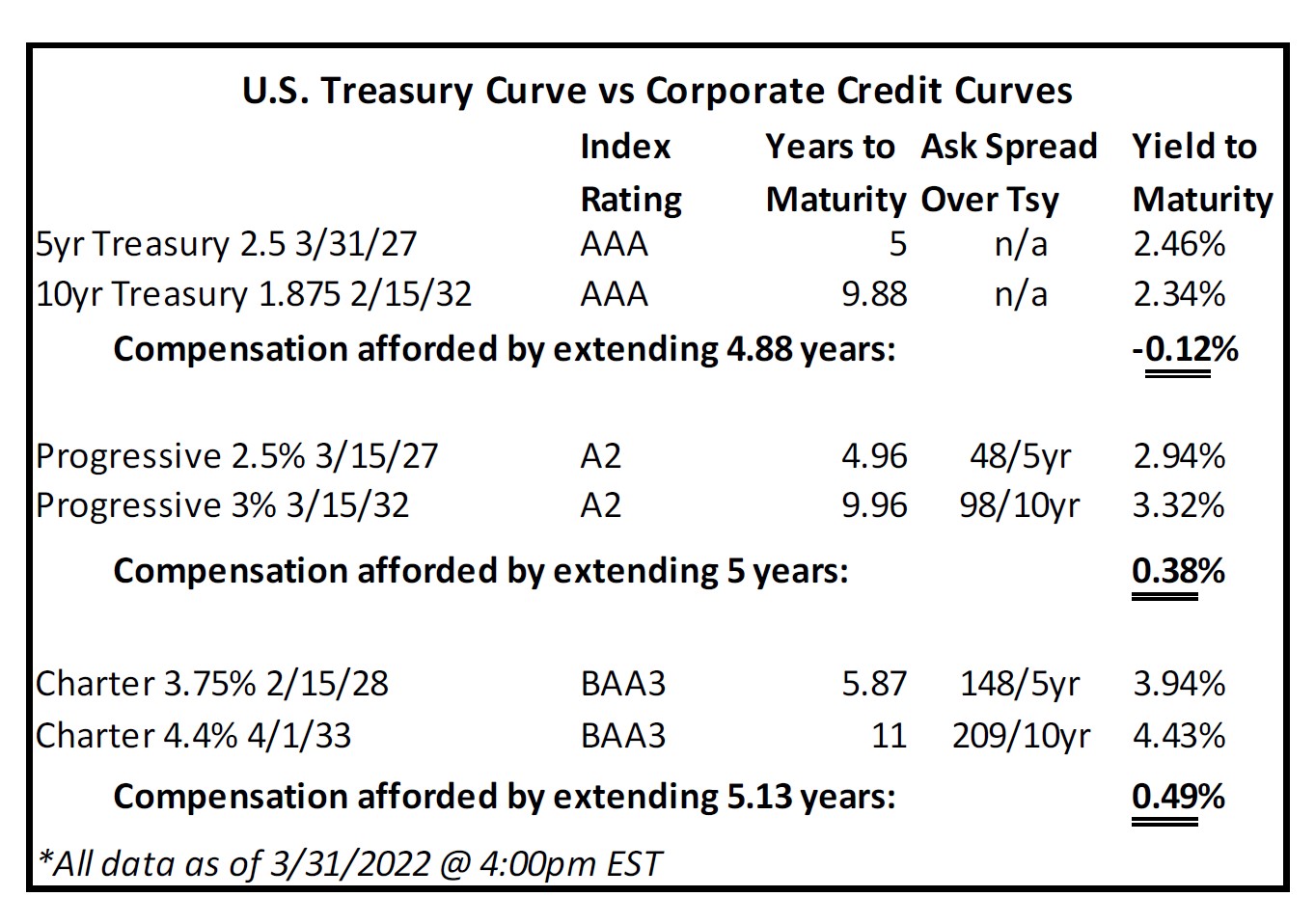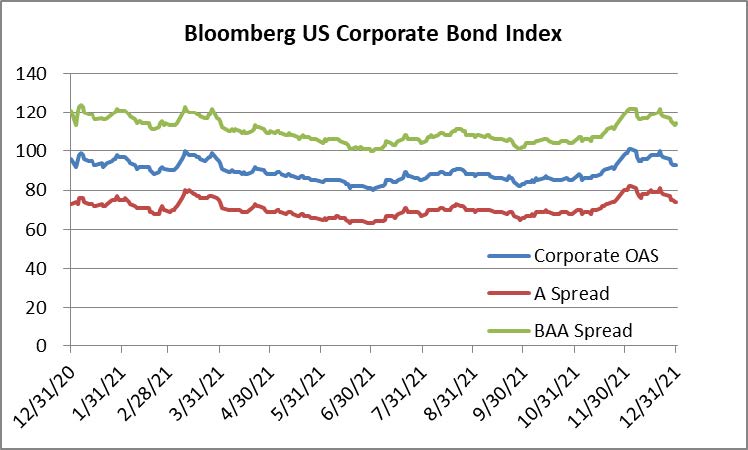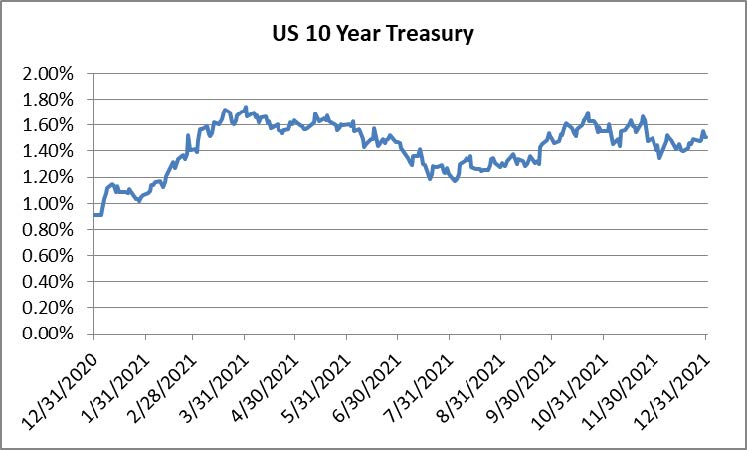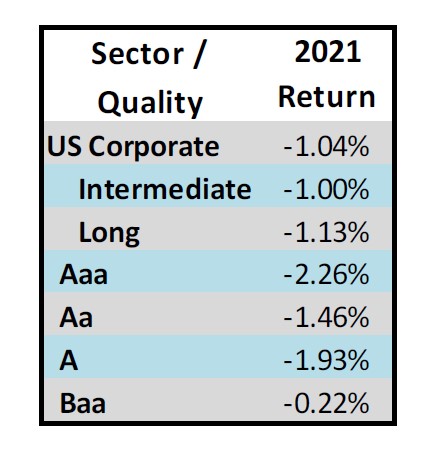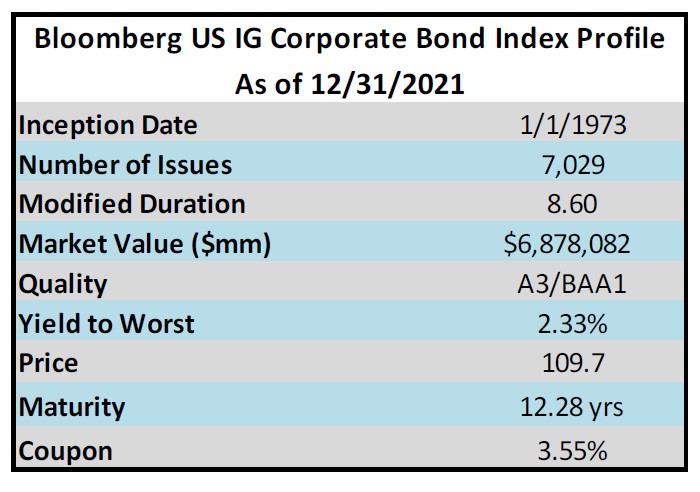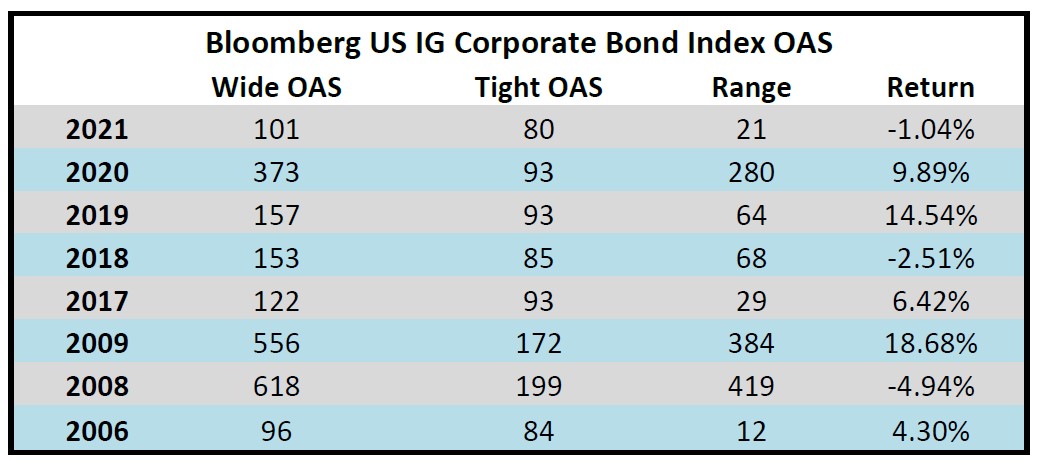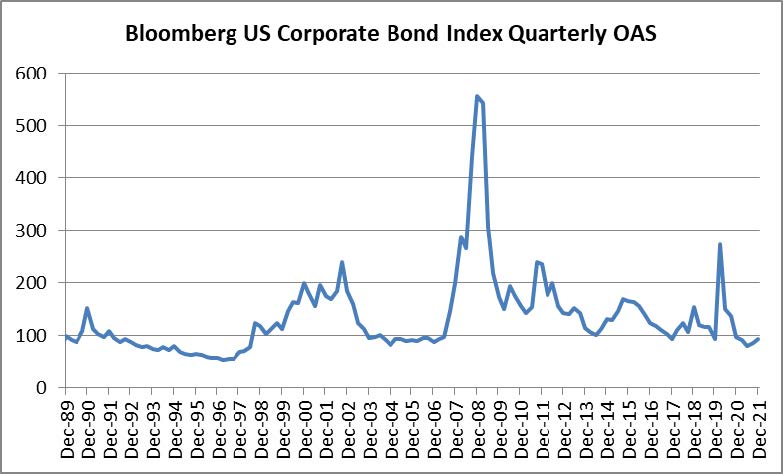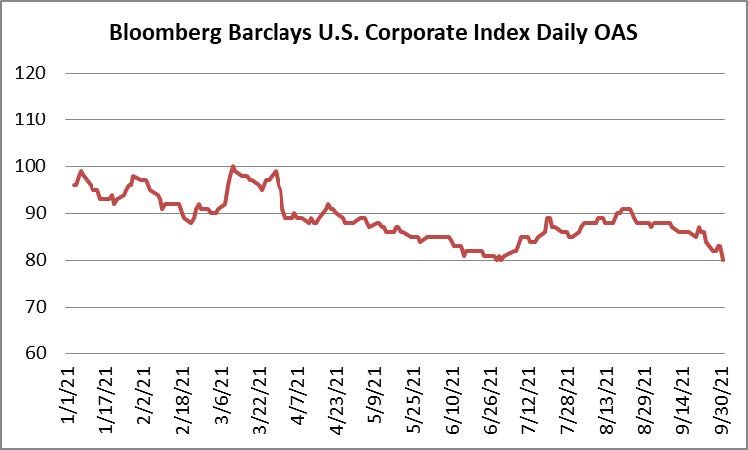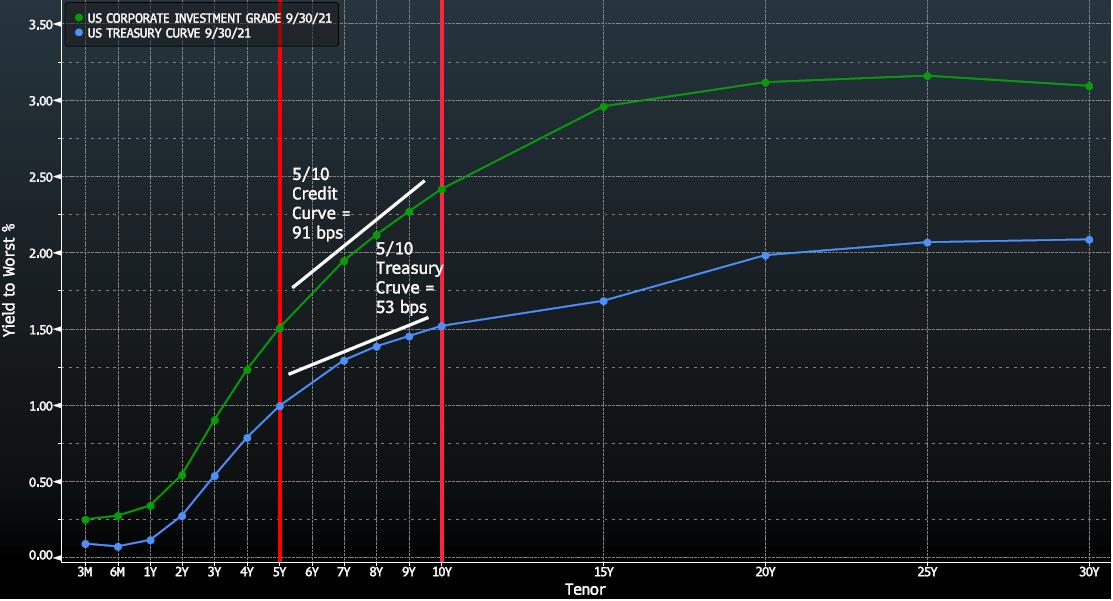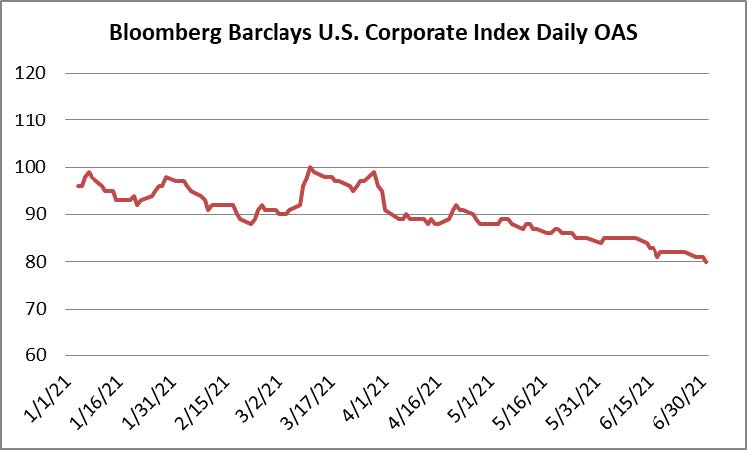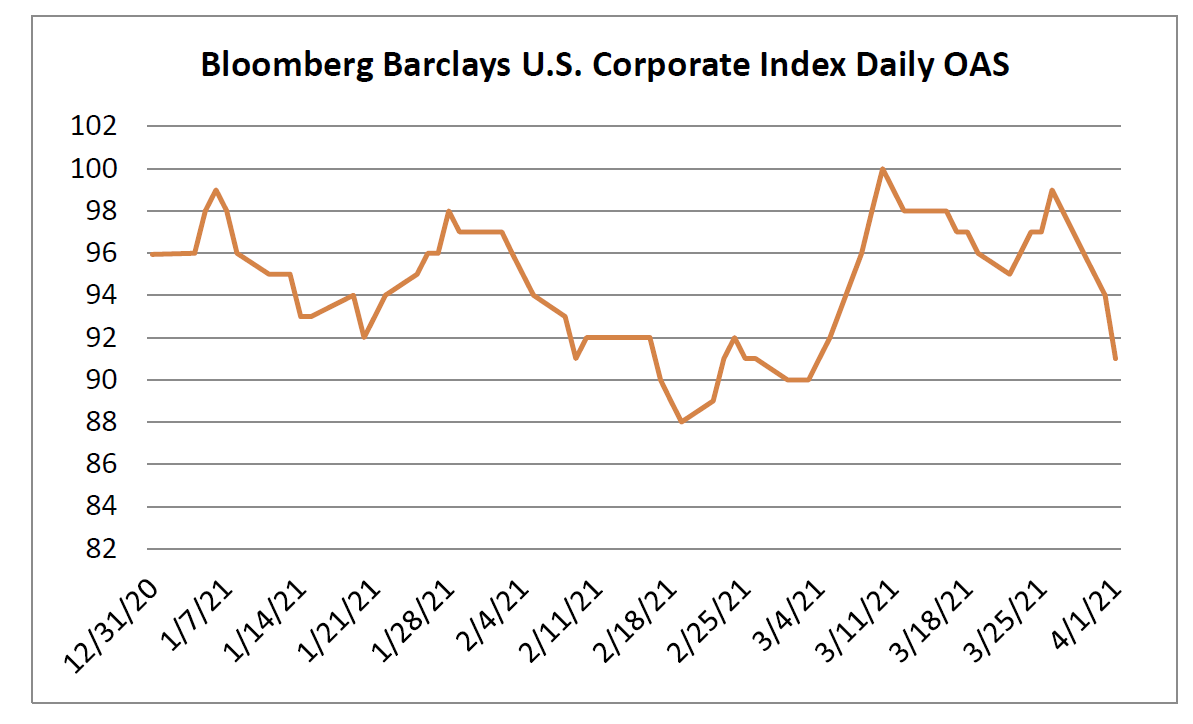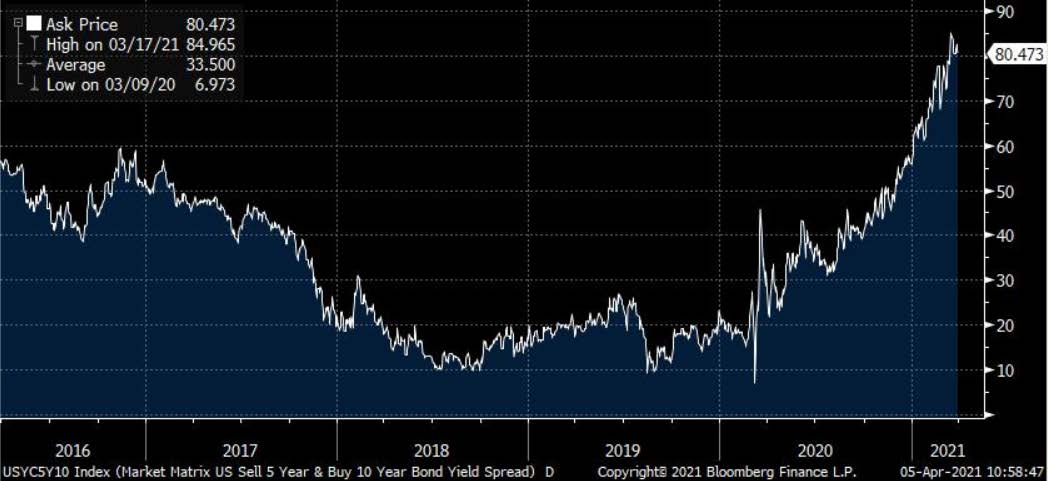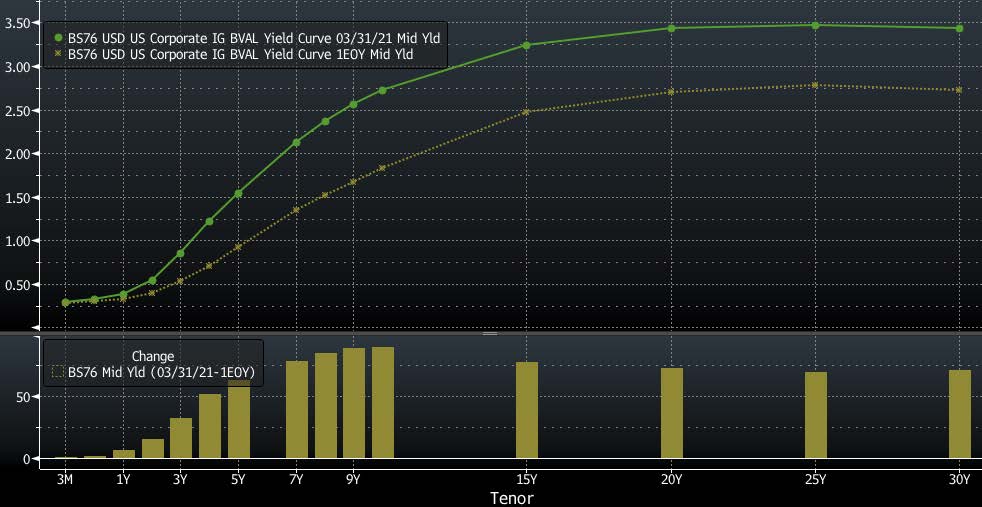Investment grade credit posted solid positive total returns to start 2023. During the first quarter, the Option Adjusted Spread (OAS) on the Bloomberg US Corporate Bond Index widened by 8 basis points to 138 after having opened the year at 130. With wider spreads, positive performance during the quarter was driven by coupon income and a rally in Treasuries with the 10yr Treasury finishing the quarter at 3.47%, 41 basis points lower year‐to‐date.
During the first quarter the Corporate Index posted a total return of +3.50%. CAM’s Investment Grade Program net of fees total return during the quarter was +3.41%.

Investment Grade is Fashionable Again
In our last commentary we wrote that total returns for investment grade credit may be poised to rebound from the depths. The Corporate Index has now posted two consecutive quarters of positive total returns with 4Q2022 and 1Q2023 coming in at +3.63% and +3.50%, respectively. 2022 was the worst full year total return for IG credit on record (‐15.76%) and November 7th was the bottom from a performance perspective. Since November 7th the Corporate Index has posted a positive total return of +8.89%, illustrating just how quickly market temperament can change; which is one of the reasons we caution against trying to time the market.
Short term Treasuries are currently available at some of the highest yields in years. The 2‐year Treasury closed the first quarter of 2023 at 4.03% and we believe that short duration Treasuries are an attractive cash alternative. While short term rates may be an attractive place to park some cash, we do not believe that they are a suitable replacement for an intermediate corporate bond portfolio for most investors due to the high degree of reinvestment risk incurred. When the Federal Reserve pivots and begins to cut its policy rate short term Treasury yields are likely to follow. At that point, an investor looking to replace their short‐term Treasuries may find that intermediate credit has since rallied significantly on a relative basis making the entry point for IG credit potentially less attractive than it is today. By eschewing intermediate corporates and limiting fixed income allocations to short duration assets an investor risks giving up a meaningful amount of total return potential. For certain asset classes, tactical positioning and attempts at market timing may well be a beneficial endeavor. However, we do not think that Investment Grade credit is one of those asset classes. We instead maintain that it is more effective for investors with medium or longer term time horizons to view IG credit in a strategic manner, and to give the asset class a permanent allocation of capital within a well‐diversified investment portfolio.
Money & Banking
Given the turmoil in the Banking industry we thought it would be instructive to comment on CAM’s exposure and investment philosophy as it pertains to the Financial Institutions sector.
The Finance sector comprises a large portion of the Corporate Index, with a 33.07% weighting within the index at the end of the first quarter 2023. Banking was the largest industry within the Finance sector with a 23.22% index weighting. The remaining industries that make up the balance of the Finance sector are Brokerage & Asset Managers, Finance Companies, Insurance, REITs and Other Finance. CAM has always sought to limit each client portfolio to a 30% (or less) weighting within the Finance sector to ensure that each portfolio is properly diversified from a risk management standpoint. At the end of the first quarter, CAM’s portfolio had just under a 20% exposure to the Banking industry while the rest of our Financial sector exposure was comprised of P&C Insurance (three companies) and REITs (two companies).
As far as exposure to the Banking industry is concerned, CAM is highly selective with investments in just 11 banks at the end of the first quarter 2023. Our disciplined approach to the Banking industry has always been to focus on well managed highly capitalized institutions that have broadly diversified revenue streams and geographically diverse lending footprints. The fundamental nature of CAM’s investment philosophy and bottom up research process excludes specialty banks and regional banks because their loan portfolios have outsize exposure to particular industries or their footprints are too concentrated. We apply the same type of rigorous analysis to our Finance exposure in both the Insurance and REIT industries. As a result, we have a high degree of confidence in our investments within the Financial Institutions sector.
Aversion to Inversion
We continue to receive questions from investors about the inverted yield curve and its impact on the portfolio. There are two major themes to discuss.
- For new accounts, the inversion has brought good fortune, creating an attractive entry point; and seasoned accounts enjoy this same benefit as they make additional purchases. The inverted curve has consistently created situations where it is opportunistic to buy shorter intermediate bonds that we believe are likely to perform well as the curve normalizes over time. We have been able to purchase bonds that mature in 7‐8 years at prices that are attractive relative to 9‐10 year bonds. This results in a lower overall duration for the client portfolio and less interest rate risk. These types of opportunities are much more fleeting during environments with normalized upward sloping Treasury curves.
- For seasoned accounts or those that are fully invested, they will find that our holding period will be longer than usual. This is because the yield curve inversion has resulted in less attractive economics for extension trades. Rather than selling bonds at the 5‐year mark, as we typically would, we will continue to hold those bonds and collect coupon income while we wait for curve normalization. We will exude patience, constantly monitoring the landscape for extension opportunities to present themselves, meaning we are likely to hold existing bonds until there are 3 or 4 years left to maturity so long as the curve remains inverted.
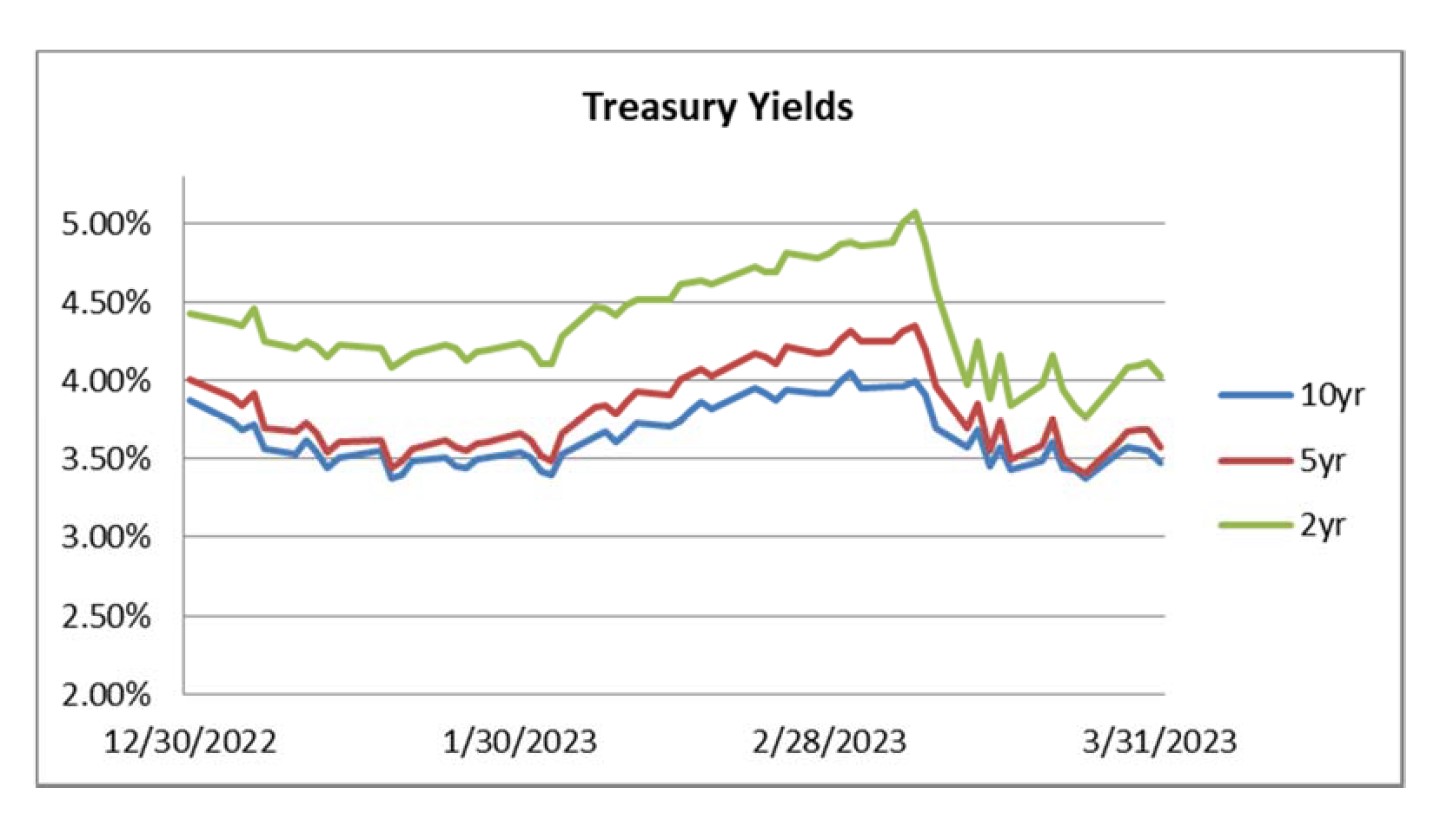
Treasury curves will normalize –they always have. Historically, curve inversions have been brief in nature with the longest period of inversion on record for 2/10s being 21 months from August 1978 until April 1980.i The current 2/10 curve inversion began on July 5 2022 and was at its most deeply inverted point of ‐107 bps on March 8, 2023 before sharply reversing course to finish the quarter at ‐55 bps. The most likely catalyst for an upward sloping yield curve is a Fed easing cycle and a decrease in the Federal Funds Rate. The mere anticipation of a pause in the hiking cycle could be enough for the market to begin the process of returning to a more normalized Treasury curve.
Market Conditions & New Issuance
Demand for investment grade credit has been consistently strong to start the year. According to sources compiled by Wells Fargo, IG funds reported $62.1bln of inflows year‐to‐date through March 15.ii We have observed this demand and its associated impact on pricing in the primary market, from large institutional buyers in particular. Our invest‐up period for a new account averages 8 to 10 weeks. For new accounts we historically have been very consistent in that we have been able to find compelling opportunities in the primary market so that a new account could expect to have 30‐35% of its portfolio populated by new issuance. Seasoned accounts too could expect to purchase new issuance from time to time as coupon income is received within those accounts and cash builds to the point that the account is ready to make a purchase.
Let’s walk through the mechanics of what we are currently observing within the primary market:
A company and its investment bankers, in a normalized market with a balanced level of demand, could expect to pay what we call a “new issue concession” to investors in order to incentivize them to purchase a newly issued bond. For example, if a company has a 9‐year bond outstanding that trades at a spread of 100/10yr then it would be entirely reasonable for an investor to expect to be paid 115/10yr to compensate for the additional duration incurred as well as some compensation in the form of extra spread to incent the investor to buy the new bond. New issue concessions change frequently and are based on market dynamics including the state of the economy, geopolitical issues, overall demand for credit, as well as characteristics of the issuing company and prevailing opinion of its’ credit worthiness. Sometimes new issue concessions can be very attractive and other times they can be flat or even negative.
Throughout the first quarter we observed a high frequency of flat/negative new issue concessions which made for situations where the secondary bonds of a given issuer were more attractive than the new bonds. Sometimes this meant that the secondary bonds were an opportunistic investment relative to the new bond but other times it meant that both secondary and the new bonds were fairly or overvalued based on our analysis. The reasoning to purchase a 10yr bond that offers less yield than an 8yr bond may seem counterintuitive, but the rationale lies in how we consider the constraints placed upon investors in the corporate bond market. Bonds are finite, trade over the counter (not on an exchange) and are less liquid than equities. There is a major problem that a willing buyer of a bond may face from time to time –what if there are no willing sellers? Complicating matters for the buyer in our example –what if the buyer has a lot of cash that needs to be invested? This is the phenomenon that we are observing currently; very large buyers that are willing to “pay‐up” in order to get money to work. The large buyer cannot just go out and buy $10-$50mm of the secondary bond because there simply aren’t enough willing sellers. Instead the large buyer must pay a premium in order to put its money to work by paying too much (in our view) to buy a bond in the primary market. This is not a problem for CAM and highlights one of our comparative advantages. As a boutique manager we are still small enough that we can freely operate and buy what we need in an opportunistic manner in order to fill client accounts. If given the choice to buy a shorter bond at a higher yield than a longer bond of the same issuer, then we will buy the short bond all day long as long as the bond math makes economic sense. While the newer bond will likely have a higher coupon because it is being priced off of a higher Treasury rate than the 8yr bond that was priced two years, coupon alone does not tell the entire story. Spread and the amount of yield per turn of duration is the real key to generating total return, not coupon. The following example is a real‐world one that we observed in early February of this year:

The new bond was from an issuer that we hold in high regard and a company that we currently invest in for client accounts (note: we have omitted the name of the company as this is not a recommendation to buy or sell a specific security). The initial price for the new issue was +170bps/10yr, a level that we considered to be attractive given the credit worthiness of the issuer and its relative value within the market at that time, but that price was merely a starting point. For new issues, the initial price will change in response to the strength of demand and it is a very fluid process that occurs over the course of a few hours. In this particular instance, we would have been willing to purchase the new bond at a spread of +160bps or better but given very strong buyer demand, the syndicate was able to move the pricing in to +143bps at which point we declined to participate. Thus in this scenario, given the option between buying the new bond and the secondary bond, we would most certainly choose the secondary bond for a variety of reasons. The secondary bond offered 2bps more yield, required an upfront investment of $14 less because of its discounted price, and it was 29 months shorter in maturity than the new bond, offering meaningfully more yield per turn of duration. As it turns out we elected not to purchase the secondary bond in this example as we considered it to be fully valued at that time and not an opportunistic way to deploy capital for clients. If the bond would have been trading at a spread of +150 we would have purchased it. This is just but one example of our investment discipline in how we approach the decisions we are making for clients on a daily basis. Hopefully this is helpful in explaining some of the dynamics that we have been seeing in the market to start the year and how we think about managing risk and opportunities for client accounts.
What Will The Fed Do?
We know that the Fed can’t raise its policy rate forever. We have already seen the consequences of this unprecedented hiking cycle as cracks have emerged in some corners of the banking industry and we believe it is becoming increasingly clear that monetary policy is beginning to slow the economy. At the end of the first quarter of 2023 Fed Funds Futures were pricing a +25bp rate hike at the May meeting and a 43% chance of a +25bp hike at the June meeting. Perhaps more surprising is that futures were also predicting three policy rate cuts in the last three months of the year. We have since received a weak job openings report on the morning of April 4 that showed that labor demand and job openings have cooled with US job openings dipping below 10 million for the first time since May of 2021.iii The next big data point will be the March Employment Report which will be released on April 7th. We think that the Fed will continue to use data as its guide, particularly as it relates to employment. If the labor market cools significantly then the current hiking cycle could have already reached its peak. If the labor market is resilient then we foresee another 1‐2 hikes and possibly more if needed. At present, we have a difficult time envisioning cuts in 2023 and we think a multi‐month pause is the more likely path.
We continue to believe that the Fed has little choice –it has to tighten conditions by too much or for too long which in all likelihood will lead to recession. Predicting the timing or depth of any recession is difficult so we find it more productive to focus on the risks that we can measure and best control within our portfolio and credit risk is the one variable where we can exert the most influence. We believe we are well equipped to manage and evaluate credit risk for client portfolios through the work of our deeply experienced team. A recession is not generally good for risk assets but it is not a death knell for investment grade credit. These companies are investment grade for a reason and if we have done our job and populated the portfolio appropriately then we believe our portfolio will perform well regardless of the economic environment. We look for companies that have resilient business models and highly competent management teams as well as significant financial wherewithal and cushion. We believe IG credit would outperform the majority of risk assets if we end up in a Fed‐drive recession scenario.
Time Marches On
Credit is off to a good start in 2023 but there is still plenty of work to do to erase the negative returns of 2022. Thankfully, time is the biggest friend of bond investors. Bonds have a stated maturity and those that are trading at a discount will move closer to par with the passage of time. Time also allows investors to reap coupon income. We believe the future is bright for bond investors that are in it for the long haul. Risks remain, to be sure, and we are particularly concerned with geopolitical risks. We also can’t help but wonder what stones have yet to be uncovered as it relates to the speed with which the Fed has increased its policy rate. We will continue to grind away for you and for the rest of our clients doing our best to earn a superior risk adjusted return. Thank you for your continued interest and for your confidence in us as a manager.
This information is intended solely to report on investment strategies identified by Cincinnati Asset Management. Opinions and estimates offered constitute our judgment and are subject to change without notice, as are statements of financial market trends, which are based on current market conditions. This material is not intended as an offer or solicitation to buy, hold or sell any financial instrument. Fixed income securities may be sensitive to prevailing interest rates. When rates rise the value generally declines. Past performance is not a guarantee of future results. Gross of advisory fee performance does not reflect the deduction of investment advisory fees. Our advisory fees are disclosed in Form ADV Part 2A. Accounts managed through brokerage firm programs usually will include additional fees. Returns are calculated monthly in U.S. dollars and include reinvestment of dividends and interest. The index is unmanaged and does not take into account fees, expenses, and transaction costs. It is shown for comparative purposes and is based on information generally available to the public from sources believed to be reliable. No representation is made to its accuracy or completeness. Additional disclosures on the material risks and potential benefits of investing in corporate bonds are available on our website: https://www.cambonds.com/disclosure‐statements/.
The information provided in this report should not be considered a recommendation to purchase or sell any particular security. There is no assurance that any securities discussed herein will remain in an account’s portfolio at the time you receive this report or that securities sold have not been repurchased. The securities discussed do not represent an account’s entire portfolio and in the aggregate may represent only a small percentage of an account’s portfolio holdings. It should not be assumed that any of the securities transactions or holdings discussed were or will prove to be profitable, or that the investment decisions we make in the future will be profitable or will equal the investment performance of the securities discussed herein.
i St. Louis Fed, 2022, “10‐Year Treasury Constant Maturity Minus 2‐Year Treasury Constant Maturity”
ii Wells Fargo Securities, March 16 2023, “Credit Flows | Supply & Demand: 3/9‐3/15”
iii Bloomberg, April 4 2023, “US Job Openings Fall Below 10 Million for First Time Since 2021”

